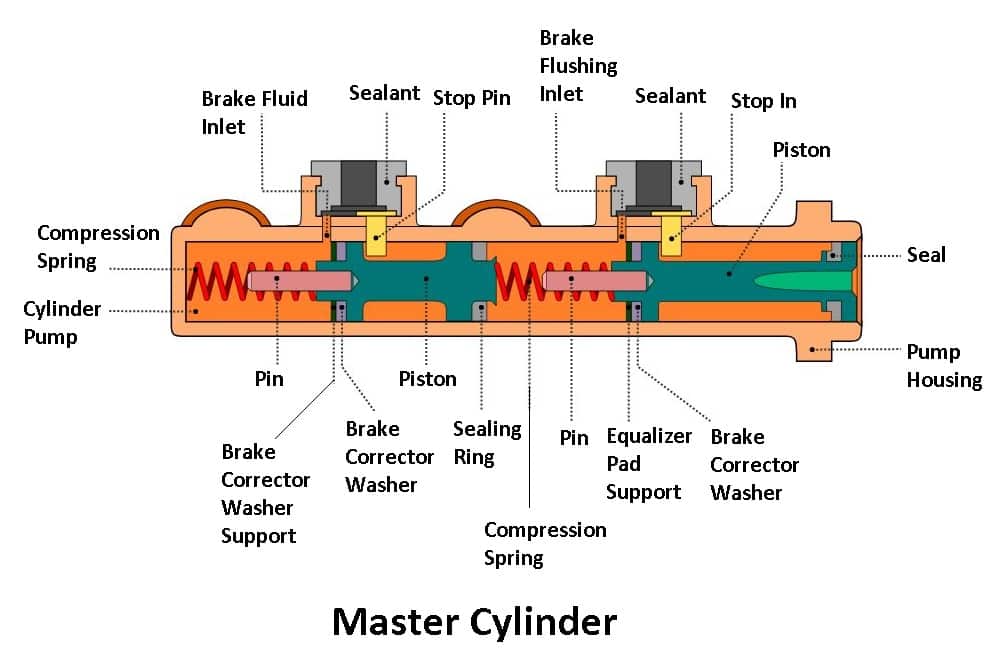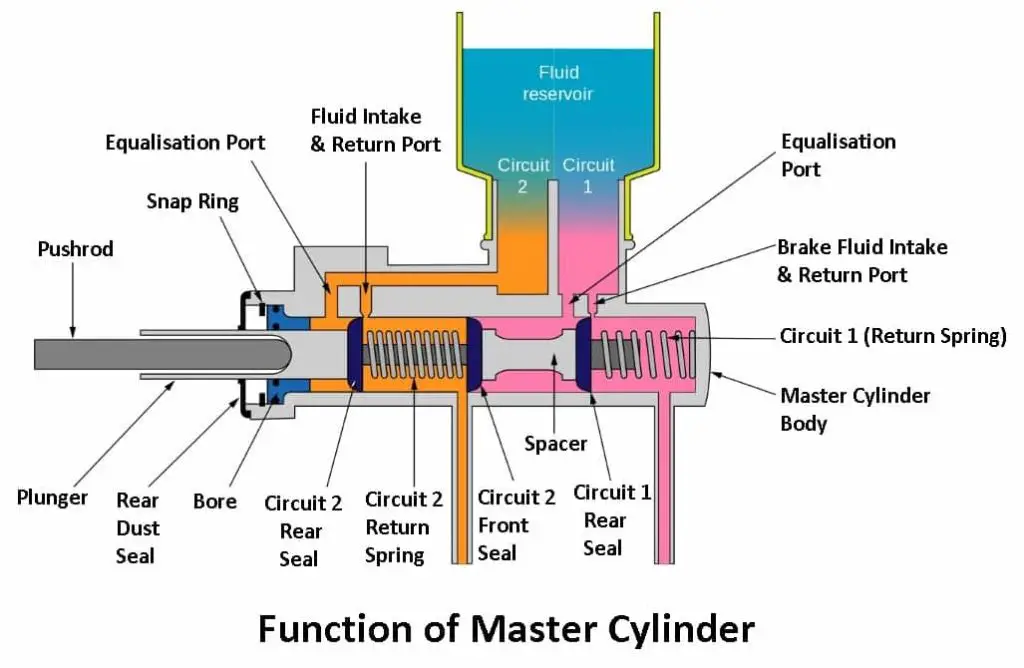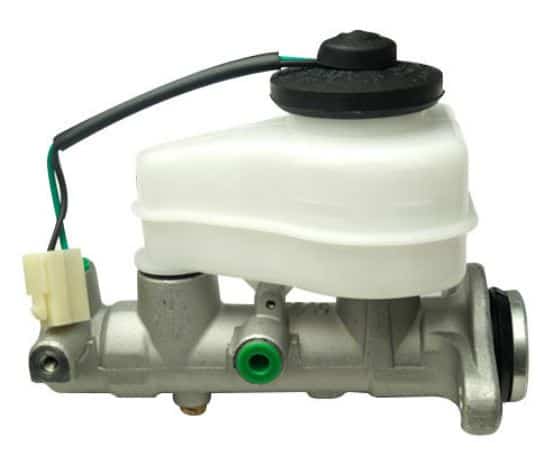In this article, you’ll learn what is Master Cylinder? Its Diagram, Parts, Function, Types, and Symptoms are explained in detail.
Also, you can download the free PDF file of this article at the end.
What is a Master Cylinder?
The master cylinder is a device that converts force (usually from the driver’s foot) into hydraulic pressure. The purpose of this device is to control the slave cylinders located at the other end of the hydraulic brake system.
It is a braking system component that transmits the pressure generated by the brake pedal on your vehicle’s wheels. It is known as the heart of your car’s brake system. The master cylinder is an equally important part of a disc brake assembly, as is the brake disc/rotor.
When the driver depresses the brake pedal, that force pushes a piston through the brake cylinder, converting the force into hydraulic pressure. This pressure pumps hydraulic fluid through the brake lines that transmit pressure to a secondary cylinder on each wheel braking system.
It is usually made of aluminum metals or cast iron. To understand more about the Brake Master Cylinder, I briefly explained its function, parts, and types. So let’s read deeply.
Read Also: What are the Common Symptoms of a Braking System?
Parts of Master Cylinder
Following are the main parts of the master cylinder:
- Reservoir
- Cylinder
- Piston
- Piston assembly
- Spring return
- Valve
- Brake pedal
- Brake fluid
- Series of gasket
- Clamp

#1 Reservoir
The reservoir generally stores brake fluid in hydraulic-type braking systems. It is usually made of aluminum or cast iron or sometimes plastic.
The shape of the reservoir is rectangular, but sometimes round-shaped reservoirs are used for rear disc brakes. This reservoir is designed in such a way that you can check the oil level and color of the oil.
#2 Cylinder
It is the air-tight housing inside which the piston travels with the moment of the brake pedal, resulting in the change and multiplication of force. This cylinder is made of either cast iron or aluminum.
#3 Piston
When you depress the brake pedal, the piston rotates inside the cylinder. Due to this, the piston causes compression of the brake fluid inside the cylinder, generating high hydraulic pressure. The MC piston is attached to a push rod and return springs.
#4 Piston Assembly
A piston assembly is basically a set of parts that includes a piston, a series of o rings/gaskets also known as cup/o rings, circle P, primary cup and secondary cup, and a return spring. The piston assembly is located near the bore of the master cylinder.
#5 Spring Return
It is a type of spring mounted inside the cylinder that helps the piston and brake pedal to maintain their original position once the brake pedal is released. It can also be seen in drum brake and disc brake assemblies.
#6 Valve
This is the valve through which the brake line is connected. With the help of this valve, compressed brake fluid is further transferred to the caliper.
#7 Brake Pedal
The brake pedal is an essential part of the master cylinder assembly from which you give instructions to the master cylinder.
#8 Brake Fluid
Brake fluid is usually hydraulic fluid. It is considered as important as oil for an engine. The primary function of brake fluid is to allow the vehicle to apply force to the brakes and to slow down and stop.
#9 Bladder
This part is typically found in an open system type master cylinder. It is made of thin rubber, which allows it to deform through expansion and contraction. It carries liquid on one side and atmosphere on the other.
#10 Series of Gasket
The series of gaskets include a cup or O ring, primary cup, secondary cup, and circle P. A cup and circle P acts as a retainer for the piston and is located between the pushrod and the piston.
The primary seal allows brake fluid from the reservoir to flow into the brake hose pipe when the brake lever or pedal is pressed, whereas the secondary seal keeps the brake fluid sealed and prevents it from flowing to the outer side when the brake pedal is pressed.
Read Also: What is the function of an Engine Valve? It’s Working & Types
Function of Master Cylinder

The master cylinder is a vital part of a vehicle. The MC converts the force of the foot into hydraulic pressure. An MC is almost a tandem brake master cylinder so let’s discuss its working principle.
First, we will discuss the MC with compensating ports. This MC consists of a reservoir tank that contains the brake fluid and cylinder rubber piston cups are employed in the cylinder. These rubber piston cups formed brake circuits.
Since there are two brake circuits, such a master cylinder is called a tandem brake master cylinder. The ports of the MC are located in the top part of the cylinder, and the outlet ports for the brake lines which are connected to the brakes are located on the side of the cylinder.
When the driver depresses the pedal, the pushrod pushes the first rubber piston cup over the compensating port. Consequently, pressure is built up in the first brake circuit, as a result, the second rubber piston cup is moved over the second compensating port and pressure builds in the second brake circuit.
Occasionally brake lines can leak or snap for this reason spilt brake systems are mandatory in many countries. If one brake circuit goes bad, the other still works. Passenger cars typically have either a front-rear split brake system or a diagonal split brake system.
In a front-rear split brake system, the first brake circuit provides pressure to the front brakes. The second brake circuit provides pressure to the rear brakes.
In a diagonal split brake system, one brake of the rear wheel and one brake of the front wheel are supplied by one of the twp brake circuits.
Checkout: Different Types of Axles Used in Vehicles [PDF]
Types of Master Cylinder
Following are the types of master cylinders used in hydraulic brakes:
- Open system
- Closed
- Single cylinder
- tandem cylinder
- Portless master cylinder
#1 Open System
This type is composed of a bladder inside the reservoir tanks. These bladders help adjust the brake fluid level in the MC. It expands or contracts according to changes in heat as one side of the bladder is exposed to the environment.
| Advantages | Disadvantages |
|---|---|
| It automatically adjusts the brake fluid level in the MC assembly. | Because it automatically adjusts, which is not good sometimes. |
| In disc brake systems, this usually protects the brakes from overheating. | When brake pads wear out, the open system supplies more fluid to the caliper, resulting in the piston being adjusted according to the worn pads. |
| The driver does not need to apply the brakes as it is an open system. | If this continues, a situation may arise where the driver needs to change the disc and caliper assembly. |
#2 Closed System
The closed system master cylinder has a reservoir tank that does not have a bladder. Hence the system needs manual adjustment.
| Advantages | Disadvantages |
|---|---|
| The driver can check the brake fluid level through the reservoir tank and replace it with the recommended levels. | If the brake fluid level is not at the recommended level, it can affect braking performance. |
| These types are widely used in all kinds of automobiles. | It typically leads to the problem of overheating. |
| If brake pads wear out, they can be easily detected and replaced. | When air remains anywhere in the system, it can also affect braking performance. |
#3 Single Cylinder
In this type, the brake pedal lever pushes the piston inside the cylinder, pushing fluid through the lines and into the slave cylinder. When the brake pedal is released, a spring is installed inside the cylinder, pushing the piston back to its original position.
The created negative pressure draws brake fluid out of the lines and into the cylinders from the brake fluid reservoir. Single-cylinder type distributes the same force on all the wheels due to the use of a single-piston or circuit.
#4 Tandem or Dual Cylinder
It is a modified variant of the MC in which dual-cylinder-dual-piston or single-cylinder dual-piston is used for independent braking between the front and rear wheels. It provides freedom between the front and rear wheels braking, an important safety feature for a vehicle.
When the brake pedal is depressed, the primary piston exerts pressure on a spring attached to the rear of the secondary piston. As the spring is compressed, the secondary piston begins to push fluid through its dedicated system. These are used in almost all cars as it is more efficient than single circuit MC.
#5 Portless Master Cylinder
The portless type provides a faster brake release than standard designs that use a compensating port. It consists of a valve assembly in the piston that opens to equalize pressure when the brake is released.
This allows it to do without a compensating port, which is restricted to fluid flow and reduces pressure from the brake system under the initial application. These work best with the ABS system, which uses rapid pressure modulation to adjust the braking force.
Read Also: Basic Car Interior Parts with [Name & Functions] Explained
Symptoms of Master Cylinder
A worn-out brake master cylinder can cause a number of problems. The following are some common issues that indicate a faulty master cylinder:

#1 Bad Brake Pedal Experience
The brake pedal should recall some major problems with the sealing or force distribution of the master cylinder. For example, you may notice a spongy brake pedal that will lack resistance and may slowly drop to the floor when pressed.
Also, the brake pedal may not come back on smoothly even after you remove your foot. This is due to a problem with brake fluid pressure, likely caused by a bad brake master cylinder.
#2 Leakage of Brake Fluid
Leaking brake fluid indicates something is wrong with the MC. If it does, contact the mechanic to check your brake fluid reservoir. Leaking brake fluid will cause it to drop its level. Fortunately, several seals inside the master cylinder keep brake fluid, and pressure contained. However, if a piston seal wears out, it will create an internal leak.
#3 Brake Warning Light Comes On
Brake Warning Light is one of the leading car dashboard warning lights. Modern vehicles have brake fluid levels and pressure sensors installed in the master cylinder. These sensors will automatically detect abnormal drops in hydraulic pressure and alert the driver.
So, if the brake warning light comes on, don’t ignore it. This could signify master cylinder failure, mainly when any previously explained symptoms occur.
#4 Vibration When Braking
The brake master cylinder typically consists of two separate hydraulic circuits to transfer brake fluid to two different pairs of wheels. Any fault in the circuit can cause the car to turn aside or experience vibration when the brakes are applied.
#5 Uneven Wear of Brake Pads
If there is a problem with one of the circuits in the master cylinder, it could cause uneven wear in brake pads. One set of brake pads will wear out more than the other, resulting in the car re-weaving each time the brakes are applied.
Wrapping It Up
Now, I hope I’ve covered everything you were looking for in this article. If you still have any doubts or questions regarding this topic, leave a comment below I’ll definitely reply. If you liked it, then share this with your friends.
Want free PDFs direct to your inbox? Then subscribe to our newsletter.
Download PDF of this article:
You might like to read more about automobile engineering:
I like this book versions much
Thanks for your feedback.